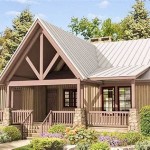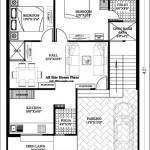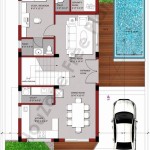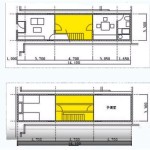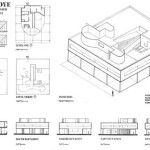Exploring the Advantages of Two-Bedroom Split-Level House Plans
Two-bedroom split-level house plans offer a unique blend of functionality and aesthetic appeal, catering to a range of lifestyle needs. This architectural style distinguishes itself through its staggered floor levels, creating distinct living zones while maintaining a compact footprint. This design approach can be particularly advantageous for smaller families, couples, or individuals seeking efficient use of space and a dynamic living environment.
The inherent structural design of a split-level house provides advantages in terms of visual separation and sound isolation. By vertically separating living areas, noise transfer between different activities can be minimized. For example, the living room might be situated on one level, while the bedrooms are located on a slightly higher or lower level, reducing the disturbance from entertainment activities when someone is trying to sleep. This creates a more peaceful and private atmosphere for all occupants. Furthermore, the split levels naturally create visual interest and can enhance the overall aesthetic appeal of the home.
Understanding the specific benefits and considerations associated with two-bedroom split-level designs is crucial for prospective homeowners looking to maximize space and functionality within a limited square footage. This article will delve into the key advantages, design considerations, and suitability factors associated with this popular housing style.
Maximizing Space and Functionality in a Compact Design
One of the most significant advantages of a two-bedroom split-level house plan lies in its ability to maximize space and functionality within a relatively small footprint. Unlike traditional single-story or two-story homes, the split-level design utilizes staggered floor levels to create a more efficient use of vertical space. This allows for the creation of distinct living zones without requiring an expansive lot or a larger overall floor area. The staggered levels can make a smaller space feel larger and more dynamic.
The vertical separation inherent in the split-level design enables a more defined separation of living areas. Typically, the main entry level will house the living room, dining area, and kitchen in an open-concept layout, facilitating social interaction and creating a sense of spaciousness. A short flight of stairs leads to the upper level, where the bedrooms and bathrooms are typically located. The lower level, often partially below grade, can be utilized as a family room, recreational area, laundry room, or additional storage space.
This segregation of functions contributes to a more organized and efficient living environment. The distinct living zones prevent the commingling of activities, allowing for a more undisturbed atmosphere in each area. For instance, activity in the living room won't directly impact the bedrooms, and vice versa. This can be especially beneficial for families with young children or individuals who value privacy and quiet.
Moreover, the split-level design can be particularly advantageous for homes built on sloping lots. The staggered floor levels can be easily adapted to the natural terrain, minimizing the amount of excavation required and reducing construction costs. This adaptability allows for a more seamless integration of the home into its surroundings, creating a visually appealing and environmentally sensitive design.
Enhanced Privacy and Separation of Living Areas
Privacy and separation of living areas are crucial considerations for many homeowners, and the two-bedroom split-level design excels in providing these essential features. The inherent structural layout of the split-level plan, with its staggered floor levels, naturally creates a visual and acoustic barrier between different living zones. This separation can significantly enhance the overall privacy and comfort of the occupants.
As mentioned previously, the strategic placement of bedrooms on an upper level, away from the main living areas, minimizes noise transfer and provides a more private and relaxing environment for sleep and rest. This separation is particularly valuable in multi-generational households or for individuals who work from home and require a quiet workspace. The physical distance between the bedrooms and the living areas reduces the likelihood of disturbances, creating a more conducive atmosphere for both work and relaxation.
Furthermore, the split-level design can incorporate additional features to enhance privacy, such as strategically placed windows and soundproofing materials. Smaller high windows can be placed to allow natural light in while preserving privacy, and sound insulation can be added to walls and floors to minimize noise transmission between levels. These design elements can further enhance the separation of living areas and create a more private and comfortable living environment.
The separation of living areas also extends to outdoor spaces. A split-level design can easily incorporate multiple outdoor areas, such as decks, patios, and balconies, each accessible from different levels of the house. This allows for a more diverse range of outdoor activities and provides opportunities for both private relaxation and social gatherings. For example, the upper level might feature a private balcony off the master bedroom, while the lower level opens onto a spacious patio for entertaining guests.
Adaptability and Design Flexibility
The two-bedroom split-level house plan is known for its adaptability and design flexibility, making it a suitable choice for a wide range of lifestyles and preferences. The staggered floor levels allow for a variety of interior layouts and design features, catering to individual needs and tastes. This inherent flexibility allows homeowners to customize the design to suit their specific requirements and create a unique and personalized living space.
The lower level of a split-level house, often partially below grade, can be easily adapted to serve a variety of functions. It can be transformed into a family room, recreational area, home office, or even an additional bedroom suite. The possibilities are endless, and the flexibility of the space allows homeowners to adapt the design to changing needs over time. This adaptability makes the split-level design a particularly attractive option for growing families or individuals who anticipate future lifestyle changes.
The staggered floor levels also offer opportunities for creative design features, such as vaulted ceilings, clerestory windows, and open staircases. These architectural elements can enhance the visual appeal of the home and create a more dynamic and engaging living environment. Vaulted ceilings can create a sense of spaciousness and airiness, while clerestory windows can bring in natural light while maintaining privacy. Open staircases can connect the different levels of the house and create a more unified and flowing space.
Furthermore, the split-level design is easily adaptable to different architectural styles. It can be incorporated into a traditional, contemporary, or modern design aesthetic, allowing homeowners to express their individual style and preferences. The flexibility of the design allows for a wide range of exterior materials and finishes, from traditional brick and siding to contemporary stucco and metal. This adaptability ensures that the split-level house can be seamlessly integrated into any neighborhood or setting.
The ability to adapt the design to sloping lots also enhances its flexibility. The staggered floor levels can be easily adjusted to accommodate the natural terrain, minimizing the need for extensive excavation and reducing construction costs. This adaptability makes the split-level design a particularly attractive option for homeowners looking to build on challenging or irregularly shaped lots.
In conclusion, while the two-bedroom split-level house plan might not be universally appealing, its inherent advantages in space optimization, privacy, and adaptability make it a compelling option for certain types of homeowners. Careful consideration of individual needs and preferences is crucial when evaluating the suitability of this architectural style.

2 Bedroom Split Level House Plan 141kr Design Plus Many More P Small Floor Plans Tiny

Pin On Housey Homey Things

Split Level House Plans Home Plan 126 1083

Pin On Floor Plans

Split Level House Plans Without Garage Drummondhouseplans Com
Split Level Homes Designs G J Gardner

Split Level House Plans Home Design 3266

Split Level House Plans Floor Designs

4x10m 13x33ft Split Level House Design 2 Bedroom Narrow Designs Loft

Familyhomeplans Com Plan Number 45253 Order Code 01web Split Level House Plans Modular Home Floor



